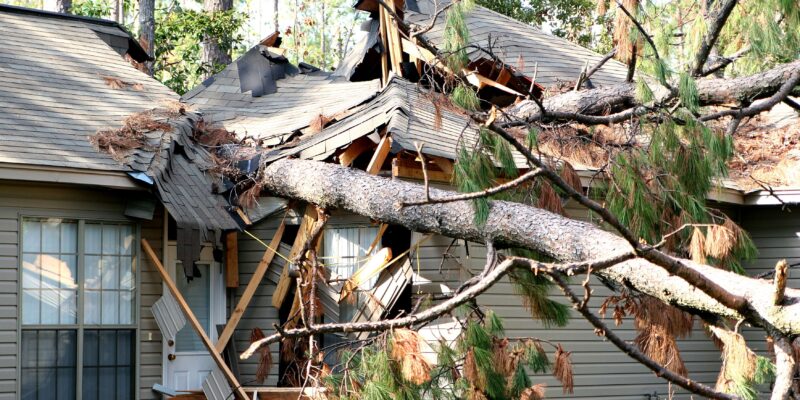
Storm damage can have devastating effects on homes, businesses, and communities. Severe weather conditions such as hurricanes, tornadoes, and thunderstorms can cause significant damage to buildings, landscapes, and infrastructure. This article will help you understand the different types of storm damage, how to protect your property, and the steps to take for a quick recovery.
Types of Storm Damage
a. Wind Damage
High winds are a common feature of storms and can cause extensive damage to buildings and trees. Wind damage can range from broken windows and shingles to complete roof removal. Trees and power lines may also be uprooted, posing additional hazards.
b. Water Damage
Heavy rain and flooding can lead to severe water damage. Floodwaters can enter homes, damaging walls, flooring, and personal belongings. Prolonged exposure to moisture can also lead to mold growth, which can be harmful to your health.
c. Hail Damage
Hailstorms can cause significant damage to roofs, siding, windows, and vehicles. The impact of large hailstones can leave dents, cracks, and holes, leading to potential leaks and structural issues.
d. Lightning Damage
Lightning strikes can cause fires, power surges, and damage to electrical systems. They can also cause structural damage to buildings, particularly if they strike trees or power lines nearby.
e. Debris Damage
Storms often result in debris being blown around, which can cause damage to homes, vehicles, and other property. This debris can include branches, broken glass, and other materials picked up by strong winds.
How to Protect Your Property from Storm Damage
a. Inspect and Maintain Your Roof
Regularly inspect your roof for loose or damaged shingles and repair them promptly. A well-maintained roof is less likely to suffer severe damage during a storm. Consider installing storm shutters or impact-resistant windows to protect against wind and debris.
b. Trim Trees and Secure Outdoor Items
Trim any trees or branches that could fall on your home during a storm. Secure outdoor furniture, grills, and other items that could become airborne in high winds. Proper tree maintenance can significantly reduce the risk of storm damage.
c. Install a Sump Pump
If your area is prone to flooding, installing a sump pump in your basement can help prevent water damage. Make sure the pump is in good working condition before storm season begins.
d. Reinforce Garage Doors
Garage doors are often a weak point during storms. Reinforce them with braces or install a wind-rated garage door to prevent wind from entering your home and causing structural damage.
e. Create a Storm Emergency Kit
Prepare an emergency kit that includes essential items such as flashlights, batteries, first aid supplies, and non-perishable food. Having a plan in place for your family’s safety during a storm is just as important as protecting your property.
What to Do After a Storm: Steps for Quick Recovery
a. Assess the Damage
Once it’s safe to do so, inspect your property for damage. Take photos or videos of any damage for insurance purposes. Be cautious of potential hazards such as downed power lines or unstable structures.
b. Contact Your Insurance Company
Notify your insurance company of the damage as soon as possible. Provide them with detailed information and documentation of the damage. They will guide you through the claims process and inform you of what repairs or replacements are covered.
c. Make Temporary Repairs
If possible, make temporary repairs to prevent further damage, such as covering broken windows or placing tarps over a damaged roof. Keep receipts for any materials or services used, as these may be reimbursed by your insurance.
d. Hire Professional Contractors
For major repairs, hire licensed and insured contractors with experience in storm damage restoration. Avoid door-to-door contractors who appear after a storm, as they may not be reputable. Always get multiple quotes and check references before making a decision.
e. Remove Debris Safely
Carefully remove debris from your property, following local guidelines for disposal. If the debris includes hazardous materials such as asbestos or chemicals, hire professionals to handle the removal safely.
Preparing for Future Storms
a. Review and Update Your Insurance Policy
Make sure your insurance policy provides adequate coverage for storm damage. Consider adding flood insurance if you live in a flood-prone area, as most standard homeowners’ policies do not cover flood damage.
b. Create a Storm Preparedness Plan
Develop a storm preparedness plan for your family, including evacuation routes and emergency contacts. Practice the plan regularly so everyone knows what to do in the event of a storm.
c. Invest in Home Improvements
Consider investing in home improvements that can help reduce the risk of storm damage, such as impact-resistant windows, reinforced roofing materials, and storm shutters. These upgrades can also increase the value of your home and may reduce insurance premiums.
Conclusion
Storm damage can be a traumatic experience, but with proper preparation and quick action, you can protect your property and recover more efficiently. Understanding the types of storm damage, taking preventive measures, and knowing what to do after a storm will help you minimize the impact on your home and ensure the safety of your family. Stay informed, stay prepared, and take proactive steps to safeguard your property against future storms.










